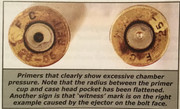Lhigginsqrb
New member
Has anyone found good load data for wt846?
They’re saying to compare to hogden but cut the load 20% then work up from there. It sounds like they’ll get sued at some point to me. I bought some for my light loads because I know those won’t get near max pressure.
I’m looking at some options. I want a chronometer anyway. Relatively cheap. But I can’t find anyone offering pressure testing services. Someone suggested starting with a recipe and working up using the chronometer as a guide. Sounds a little risky. Velocity and pressure are different variables and there’s a lot happening here that could interfere with them being proportional.
They’re saying to compare to hogden but cut the load 20% then work up from there. It sounds like they’ll get sued at some point to me. I bought some for my light loads because I know those won’t get near max pressure.
I’m looking at some options. I want a chronometer anyway. Relatively cheap. But I can’t find anyone offering pressure testing services. Someone suggested starting with a recipe and working up using the chronometer as a guide. Sounds a little risky. Velocity and pressure are different variables and there’s a lot happening here that could interfere with them being proportional.


